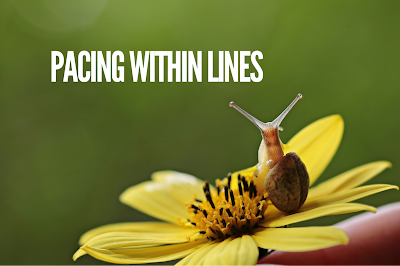When people talk about pacing in stories, they usually turn to the lines--how to make a passage or paragraph feel faster or slower.
Recently, I've been sharing how pacing happens at three levels:
- Within Lines
And it only seems right to finish up the series by visiting pacing within lines. Issues come up when a passage or paragraph feels too slow or too fast, and while line-level pacing can overlap in places with scene-level pacing, it's a little different. This is more about the way the story is written on the page.
And as I touched on in my prior posts, there is more to pacing than adding or subtracting words, even when we get clear down to the line level.
Because I've already talked about line-level pacing on here before, I thought I'd simply review a few things.
Speed Up
When:
Speed up when you want a moment to feel more intense, snappy, energetic, or even the obvious one, quick.
Often (not always) you want to speed up moments of action, especially fights. Intense scenes, quick thinking, and arguments can work well too.
And remember, often we want the text to feel tenser the closer it gets to the climax or turning point of the structural unit.
How:
Speed up the lines in these ways.
Shorten - Shorten the paragraphs, sentences, or even words. This makes the moment feel faster (for obvious reasons).
Short Syllables - Use words that have few syllables. Choose the word "dance" over "promenade," for example.
Familiar > Unusual - Choose words and concepts that are more familiar or common to the audience. For example, choose "guess" instead of "hypothesize."
Simple > Complex - Similarly, choose words and concepts that are simpler. The more technical you get, the more the audience needs to slow down and digest.
Use More Telling - Telling is faster than showing. Tell what's happening when a quick pace is absolutely needed.
Slow Down
When:
Slow down to create a more dramatic effect; to take time to be more serious, weighty, intellectual, technical, or leisurely; to give the audience important details; and to let them catch their breath and digest.
Usually, things slow down a bit after the climactic peak.
How:
You would think that slowing down would be most effective by doing everything opposite of what it says above and some of that is true, but it depends on the situation. Yes, writing longer sentences will help slow a passage down, but if you simply do the opposite of everything listed above, you can easily run into The Purple Prose problem.
Often the best way to slow down is to add more showing, details, and/or concepts.
It's like watching slow motion in a movie. The audience can see more detail. We get specific shots. Time itself seems to slow or even stop.
Slowing down in a story can work in the same way.
Notice how this moment (from an action scene) in Harry Potter slows down by getting more specific and more detailed. Up to this point, there has been fighting and action, and then something important happens, so it slows down and gets detailed.
It seemed to take Sirius an age to fall. His body curved in a graceful arc as he sank backward through the ragged veil hanging from the arch.
And Harry saw the look of mingled fear and surprise on his godfather's, wasted, once-handsome face as he fell through the ancient doorway and disappeared behind the veil, which fluttered for a moment as though in a high wind, then fell back into place.
But here's the thing about slowing pacing way down for dramatic effect, and an aspect that I see writers get a bit mixed up on a lot. Do not try to slow it down by repeating the same information the same way or even the exact same information in a different way.
That doesn't slow the pacing, it positively kills it to a dead, annoying stop. Instead, add more ideas, images, and concepts, as I explained in more detail in the second half of this article here.
Worth noting is that sometimes it's pleasing when the lines slow down once we hit a climax or turning point, because this makes that moment more dramatic--especially if the pacing was fast just before.
However, don't get hung up on trying to hit everything in just the right technical way. Sometimes pacing is more something you "hear" and feel, than something technical. Read your work aloud, and it will probably help you with pacing.
Convey More Than What's On the Page
One of the keys to making pacing work at the line level, is ideally, you want the words to convey more than what is on the page, as opposed to using a lot of words explaining what the audience already gets the first time (like I touched on above). I've mentioned this before, but this is one of the differences I often see between professional-level writing and beginning writers.
If the audience already gets it, and you are spending a lot of words describing, relaying, or explaining it, the pacing is going to start to feel slow.
In particular, this can be a problem when you show (dramatize) something in the story, then you tell (explain) it to the audience. Trust that the reader is smart enough to get it. As Pixar's Andrew Stanton once shared, you don't need to explain 2 + 2 = 4. You just need to put 2 + 2 on the page, and let the audience come to the conclusion.
We should be striving to write economically, not striving to hit word counts with filler.
Read What Others have Written on Pacing
What is Pacing in Writing? by Now Novel
7 Quick Tips for Mastering Pacing by Writer’s Edit
Pacing in Writing by Reedsy























0 comments:
Post a Comment
I love comments :)